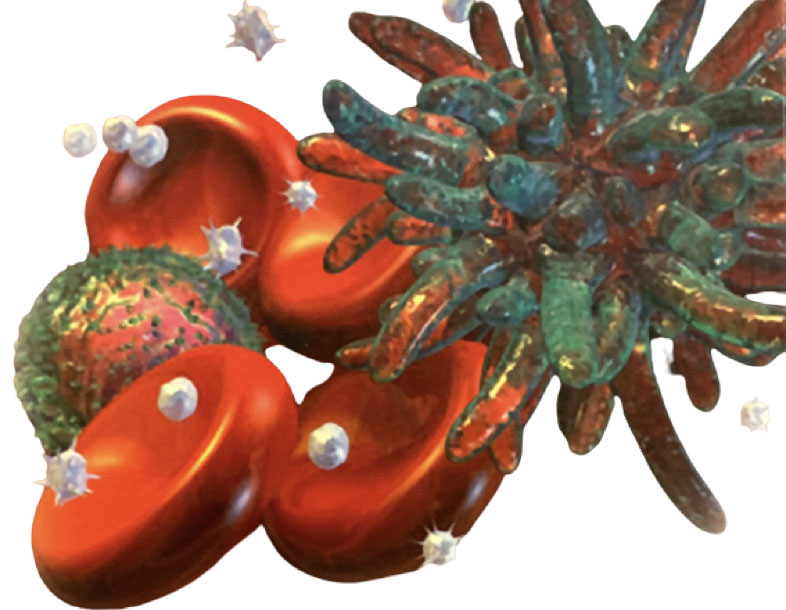By: Prof. Dr. Seyed Saeid Zamanieh Shahri, MD and Prof. Dr. Sonia Sayyedalhosseini, MD
Lymphoma is a type of cancer that forms in the lymphatic system, which is part of the body’s anti-microbial network. The lymphatic system consists of lymph nodes, spleen, thymus gland and bone marrow. Cancer of the lymph nodes can affect all those areas as well as other parts of the body.
There are different types of lymphoma. The main subgroups are:
• Hodgkin’s lymphoma (which was also called Hodgkin’s disease in the past)
• Non-Hodgkin’s lymphoma
Lymph nodes are small glands in the body that are part of the immune system. You’ve probably heard of lymph nodes, which may have been associated with a cancer diagnosis, but everyone has them and they play an important role in keeping us healthy. Scientifically, lymph nodes are part of the lymphatic system, which form a network of body organs, vessels and glands throughout the body. These glands trap bacteria, viruses and other invaders before they can lead to infection. Lymph nodes also are responsible for controlling the circulation of lymph fluid and delivering white blood cells to different parts of the body. (Similar to blood circulation in the veins).
Lymph nodes are concentrated in the neck, under the chin, under the armpits and around the groin, and you may notice swelling of these glands if you are fighting an infection in one of the body parts. These glands, which exist in the body of all humans, play an important role in human health as part of the body’s immune system by fighting infections and filtering bacteria and cancer cells. Lymph nodes are also responsible for managing the flow of lymph fluid and transporting white blood cells to different parts of the body. The lymphatic system is a network of low-pressure vessels throughout the body. These vessels are called lymphatic vessels. In addition to performing important immune functions in the body, the lymphatic system creates a path for the return of intercellular fluids to the circulatory system through the lymphatic vessels. Liquids that flow like blood throughout the lymphatic tissues of the body are called lymph or lymphatic fluid. The lymphatic system also facilitates the absorption of fats and fat-soluble vitamins in the digestive system.
Glands or lymph nodes destroy foreign cancers and fight infections in the body by destroying the cells associated with the infection through the use of white blood cells in their lymph fluid. Therefore, part of the body’s immune system cells is transferred to the lymph nodes to fight any type of disease. To put it more simply, the lymph node, as part of the immune system, is responsible for defending the body. The multiplicity of cells, in the fight against the factors of infection and cancer, causes swelling of the lymph node or gland.
Swollen Lymph Nodes:
When there is a problem in the body such as an infection, injury, or cancer, the lymph nodes in the affected area may become swollen or enlarged. Because they are working to filter abnormal cells. Swollen lymph nodes give you a sign that something is not working right in the body, but it is other, more specific symptoms that indicate the root of the problem. For example, swollen lymph nodes near the ear plus ear pain and fever are signs that you may have an ear infection or a cold.
There are some areas of the body such as the neck, groin and armpits that generally have large lymph nodes. In most cases, only the lymph nodes in one area are swollen. When the lymph nodes are swollen in more than one area, it is called generalized lymphadenopathy. Some infections, such as streptococcus of throat and chicken pox, infection caused by the use of certain drugs, diseases related to the body’s immune system, and cancers such as lymphoma and leukemia can cause these multiple swellings. Your treating doctor needs more symptoms than swollen lymph nodes to be able to find the root of the problem.
Note:
Swollen lymph nodes are often caused by diseases other than cancer.
Pathophysiology of Lymph Node Cancer:
Cancer can spread from where it started to other parts of the body. When cancer cells break away from their original tumor, they can spread to other parts of the body through the bloodstream or lymphatic system. If these cells move through the lymphatic system, cancer cells can also enter the lymph nodes. Most cancer cells escape, die, or are killed before they can start growing and multiplying elsewhere. But it is always possible that one or two cells can escape and settle in new places, grow and form new tumors. The spread of cancer to other parts of the body is called metastasis.
When cancer spreads to the lymph nodes, it often enters the lymph nodes near the area of the cancerous tumor. These are the lymph nodes that do the most anti-cancer activity to filter and kill cancer cells.
Risk factors:
Factors that can increase the risk of developing lymphoma include:
• Age. Some types of lymphoma are more common in young adults, while others are more often diagnosed in people over 55.
• Being a man. Men are slightly more likely to develop lymphoma than women.
• Immune system disorder. Lymphoma is more common in people with immune system diseases or in people taking immunosuppressive drugs.
• Occurrence of certain infections. Certain infections are associated with an increased risk of developing lymphoma, including Ebstein-Barr virus and Helicobacter pylori infection.
Signs and Symptoms:
Signs and symptoms of lymphoma may include:
• Painless Swelling of lymph nodes in the neck, armpit or groin (cancer of the neck lymph nodes, cancer of the axillary lymph nodes or cancer of the groin lymph nodes)
• Constant Fatigue
• Fever
• Night Sweats
• Shortness of Breath
• Unexplained Weight Loss
• Skin Itching















